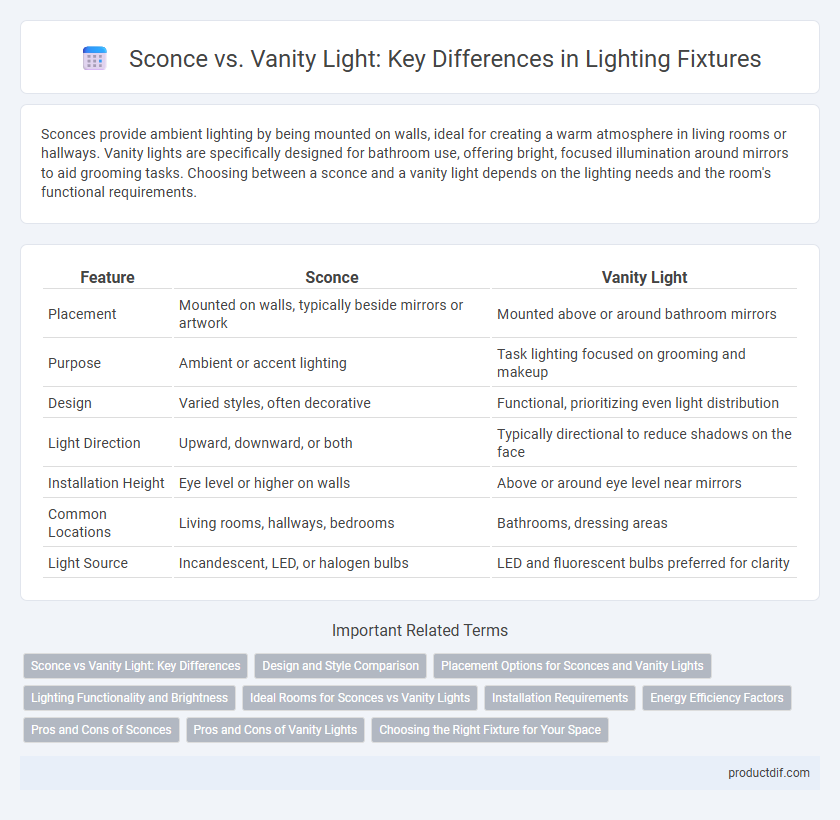Sconces provide ambient lighting by being mounted on walls, ideal for creating a warm atmosphere in living rooms or hallways. Vanity lights are specifically designed for bathroom use, offering bright, focused illumination around mirrors to aid grooming tasks. Choosing between a sconce and a vanity light depends on the lighting needs and the room's functional requirements.
Table of Comparison
| Feature | Sconce | Vanity Light |
|---|---|---|
| Placement | Mounted on walls, typically beside mirrors or artwork | Mounted above or around bathroom mirrors |
| Purpose | Ambient or accent lighting | Task lighting focused on grooming and makeup |
| Design | Varied styles, often decorative | Functional, prioritizing even light distribution |
| Light Direction | Upward, downward, or both | Typically directional to reduce shadows on the face |
| Installation Height | Eye level or higher on walls | Above or around eye level near mirrors |
| Common Locations | Living rooms, hallways, bedrooms | Bathrooms, dressing areas |
| Light Source | Incandescent, LED, or halogen bulbs | LED and fluorescent bulbs preferred for clarity |
Sconce vs Vanity Light: Key Differences
Sconces typically mount on walls and cast ambient or accent lighting, ideal for hallways or living areas, while vanity lights are specifically designed for bathroom use, providing focused illumination around mirrors. Vanity lights often feature multiple bulbs aligned horizontally or vertically to reduce shadows on the face, enhancing grooming tasks. The primary difference lies in their function and placement: sconces enhance room ambiance whereas vanity lights prioritize task lighting for bathrooms.
Design and Style Comparison
Sconces typically feature a wall-mounted design that projects light outward or upward, creating ambient or accent lighting ideal for hallways and living spaces. Vanity lights are usually installed above or beside bathroom mirrors, offering focused, even illumination designed to minimize shadows for grooming tasks. Design-wise, sconces often emphasize decorative, sculptural elements, whereas vanity lights prioritize functionality paired with sleek, contemporary styling to complement bathroom interiors.
Placement Options for Sconces and Vanity Lights
Sconces are typically mounted on walls beside mirrors, doorways, or hallways, providing ambient or accent lighting that enhances spatial design. Vanity lights are usually installed directly above or on either side of bathroom mirrors to deliver focused, even illumination for grooming tasks. Placement of sconces allows for flexible decorative accents throughout living or dining areas, whereas vanity lights prioritize functional lighting in bathrooms.
Lighting Functionality and Brightness
Sconces provide directional lighting ideal for accentuating specific areas or creating ambient atmosphere with softer illumination, making them suitable for hallways and living spaces. Vanity lights offer brighter, even illumination designed to reduce shadows, essential for grooming tasks in bathrooms or dressing areas. The choice between sconce and vanity light depends on the desired lighting brightness and function, with sconces enhancing mood and vanity lights ensuring clear, focused visibility.
Ideal Rooms for Sconces vs Vanity Lights
Sconces are ideal for hallways, living rooms, and entryways where ambient or accent lighting is needed without occupying surface space. Vanity lights are best suited for bathrooms and dressing areas, providing bright and even illumination around mirrors for grooming tasks. Selecting the appropriate lighting fixture enhances both functionality and ambiance tailored to the specific room's purpose.
Installation Requirements
Sconces typically require installation on walls at eye level, often needing a junction box for wiring, making them ideal for accent or ambient lighting. Vanity lights usually mount above or alongside bathroom mirrors, demanding precise placement for optimal illumination and compliance with electrical codes for damp environments. Both fixtures require careful consideration of wiring access and wall support to ensure secure and functional installation.
Energy Efficiency Factors
Sconces and vanity lights vary in energy efficiency primarily due to their design and typical bulb compatibility; sconces often use lower-wattage bulbs suitable for ambient lighting, while vanity lights generally require higher-lumen output for task lighting, impacting overall consumption. LED technology integration enhances energy savings in both fixtures, but sconces benefit more significantly because their usage frequency is often higher for mood lighting, leading to extended energy savings over time. Choosing fixtures with ENERGY STAR certification and dimmable LED bulbs optimizes energy use, reducing electricity costs and environmental impact regardless of installation location.
Pros and Cons of Sconces
Sconces provide versatile lighting options ideal for both ambient and accent purposes, often mounted on walls to save space and enhance decor. They create a warm, inviting atmosphere with softer illumination but may lack the focused, task-oriented brightness that vanity lights offer for grooming activities. Limited adjustability and potential for uneven lighting are notable drawbacks when using sconces in bathrooms or dressing areas.
Pros and Cons of Vanity Lights
Vanity lights offer focused illumination ideal for grooming tasks, providing even, shadow-free lighting that enhances bathroom visibility. However, they can occupy wall space above the mirror, limiting decorative options and may require professional installation for optimal placement and wiring. Vanity lights typically feature multiple bulbs, which can increase energy consumption compared to single-bulb sconces.
Choosing the Right Fixture for Your Space
Selecting the right lighting fixture depends on the room's function and desired ambiance; sconces provide accent or ambient lighting ideal for hallways and living rooms, while vanity lights offer focused illumination tailored for bathrooms and makeup areas. Consider lumen output and color temperature when choosing between a sconce or vanity light to ensure optimal visibility and mood. Fixture style and placement also impact spatial aesthetics and functionality, making it essential to match the design with your interior decor and task requirements.
Sconce vs Vanity Light Infographic

 productdif.com
productdif.com